This was published 9 years ago
Umbria farmhouse holiday: the gods of small things
During a week in an Umbrian farmhouse, Ute Junker falls in love with hill towns and hidden treasures.
By Ute Junker
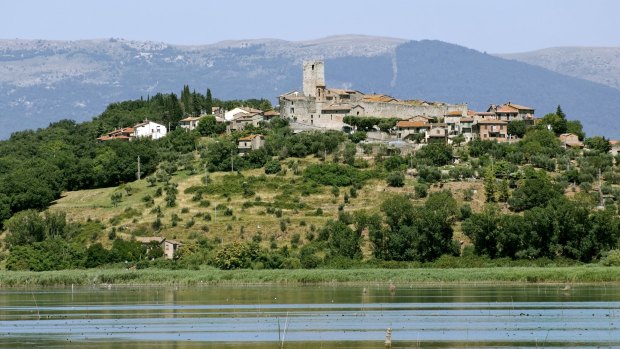
Ancient village: On Trasimeno Lake.Credit: iStock
You can learn a lot about Umbria from a glass of wine, as I discover on my first day here. To mark our arrival, our host, Giuseppe, has put on a three-course feast. We soon learn that Giuseppe puts on a three-course feast every day, although he disagrees. "It's only two courses!" he protests. "Dessert doesn't count."
I'm taken by the wine we're drinking, a deeply tinted local red called sagrantino which I've never come across before. There's a reason for that – only 100 hectares of sagrantino exist, and they're all in this area. The wine tastes of cherries and earth and has an unusually high concentration of tannins, which gives it a wonderfully inky colour.
The name sagrantino – from the Italian sagra, meaning sacred – dates back when Umbria was one of the papal states. Umbrians paid their taxes not in money, but in goods, including sagrantino wine, which was used in church.
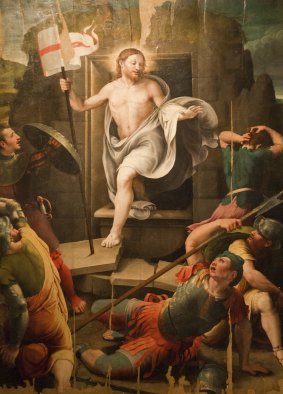
Umbrian specialty: A resurrection fresco.Credit: iStock
Fierce local loyalties, a strong agricultural tradition, a long and often conflicted history with the church: that's Umbria, and it's all in this glass of wine.
Umbria is all about the small things. They don't do monumental here: you won't find the colossal ruins, imposing palaces or labyrinthine museums that grace Italy's more high-profile destinations. Nor will you find the hordes of tourists which inevitably accompany them. Most travellers who pass through Umbria do so on the high-speed train from Rome to Florence, casting only an occasional glimpse out the window.
They're missing out. Umbria is a place that rewards old-fashioned exploring. Follow a country road and see where it takes you. Wander into a dilapidated church and discover it's held up by columns from a Roman race track, or features a delicately painted fresco by a Renaissance master. Pop into a gelato shop and try a new flavour: lavender, or liquorice, or rose.
The fortifications date back to a time when these small communities fought frequent wars.
embraces their
Our group of eight quickly sinks into the rhythms of country life. We wake at 7am to the sound of distant church bells, and finish the day sipping wine under the pine trees in the late summer twilight. Each of our lodgings in the farmhouse complex has its own entrance and a private bathroom. As locals-in-training, we quickly become partisans of our nearest town, Montefalco, just a short stroll up the hill.
Hill towns punctuate Umbria's quilt-like landscape of fields and farms, which has remained largely unchanged for centuries. With tall walls, labyrinthine streets and neat-as-a-nail houses with potted flowers livening up the ancient stones, Montefalco is typically Umbrian. The town also has a secret treasure: the old church of San Francesco, now a museum, which contains several splendid Renaissance frescoes.
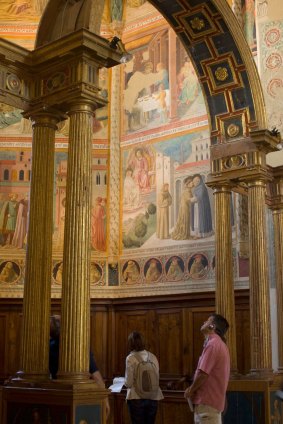
Montefalco frescoes: By Benozzo Gozzoli.Credit: Alamy
Some are in better repair than others. In some, the sky is a strange shade of purple – a sign, Neil explains, that the fresco was originally painted with blues made of lapis lazuli. This powdered stone was so valuable that in later years, the paint was scraped off for resale, leaving the tell-tale purple colouring behind.
The most magnificent frescoes in Montefalco, by Benozzo Gozzoli, depict scenes from the life of St Francis, set here in Umbria where the saint lived. In one painting, the silhouette of Montefalco itself is visible; another depicts the nearby town of Arezzo.
We discover Renaissance frescoes in almost every town we visit. In Rome or Florence, these would be museum highlights, with visitors in front of them. In Umbria's quiet churches, we are usually the only visitors. After a few days, we begin to recognise some of the painters. You can spot Perugino by his magnificently glowing colours and his penchant for including a lake in the background of his pictures. Pinturicchio, who started life as a miniaturist, delights in filling the backdrops of his pictures with countless details.
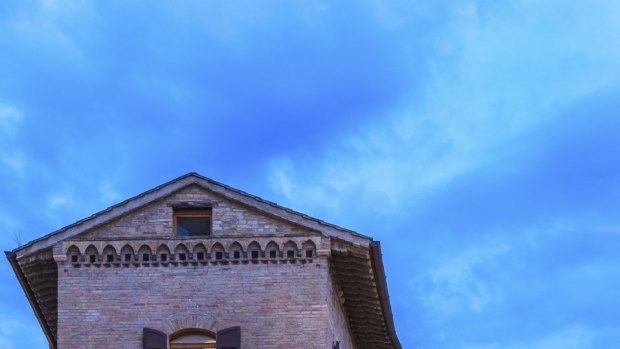
Assisi: The hometown of Saint Francis.Credit: iStock
We also become familiar with Umbria's startling array of martyred saints, who demonstrate their bloody devotion on church walls. There's Saint Ponziano, whose trials included having nails hammered in his chest and castration, and Saint Rocco, who is always shown coyly pointing to his groin. (He's not perverted – Rocco is associated with the Black Death, and is showing off his enlarged lymph node, one of the symptoms of the plague.)
The walled hill towns may be picturesque, but the fortifications date back to a time when these small communities fought frequent wars. At San Giacomo, the city's medieval core is a clear illustration of how these towns developed. It consists of just two parallel streets, surrounded by high medieval walls – a clutch of families gathered together for mutual protection in a hostile environment.
The buildings are surprisingly high, stretching six storeys up, and the towers are studded with tiny holes for pigeons, the cheapest source of protein. These tight-knit communities chose protection over privacy, and it's easy to see how this dense communal living - so different from the castles and estates where people lived in other parts of Europe - helped shape the Italian character, that embrace and involvement with each other's lives that continues today.
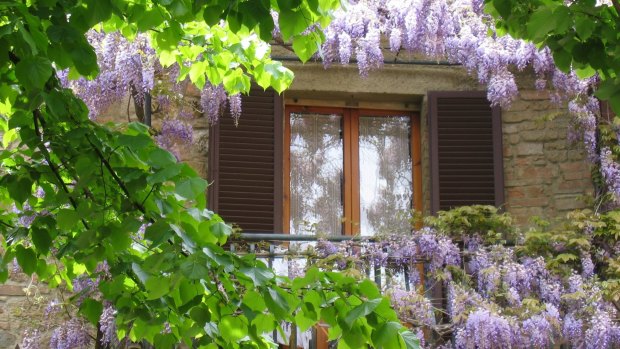
Framed balcony: Wisteria softens a stone building.Credit: Ute Junker
The fierce rivalries between towns such as Montefalco and its neighbour, Bevagna, have not entirely faded. Even today, there is no direct road connecting the two towns: the only way to get from one to another is via several other settlements. Unless, like us, you choose to walk.
Rising early one morning to beat the heat, we head down the hill for a two-hour walk to Bevagna. We start by travelling along quiet country roads lined with fig trees and blackberry bushes. Eventually we reach the river and wend our way along the bank, admiring the vineyards on the opposite side.
Like many of Umbria's hill towns, Bevagna has a history stretching back to Roman times. The ancient Via Flaminia cut through this area: in most of the towns we visit, the main street formed part of the ancient thoroughfare. In the Middle Ages, locals recycled Roman constructions to make their churches: look closely at the walls, and you will spot the occasional Roman inscriptions. Bevagna has several other Roman relics, the most charming of which is the tiled floor of an ancient bath house, playfully decorated with mosaics of sea creatures.
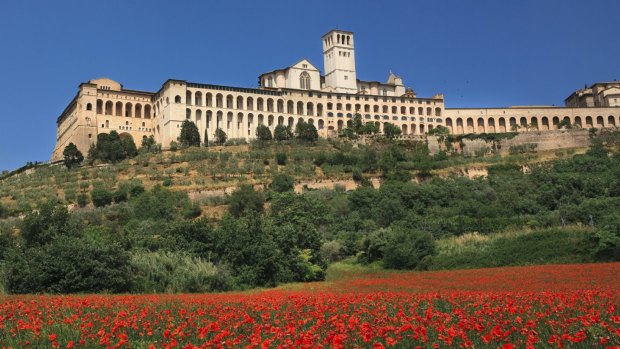
Hilltop town: Assisi.Credit: iStock
With the hill towns so closely spaced – we rarely travel more than half an hour to get anywhere - we're able to go at an easy pace. Most days we do excursions in both the morning and the afternoon, and still have time to relax. I particularly enjoy taking an after-dinner stroll, watching the fireflies dance in the long grass.
Every town offers us another glimpse into local life. In Spello, nonnas are sitting on their front steps plucking flowers that will be used to make carpets of petals for the upcoming feast of Corpus Christi. In Assisi, our guide Marco shows us the 800-year-old lions flanking the doors to the old cathedral - and then confesses that when he was a boy, the lions acted as goalposts for the games of football he and his friends played with the priest.
In Perugia, the area's largest city, we admire the mighty Etruscan gates and the elaborate frescoes commissioned by merchants in Renaissance times. The most impressive display of power, however, lies underground: a medieval ghost town with a brutal story behind it.
The Perugians, we learn, were an ornery bunch, continually rebelling against their papal overlords, particularly against the much-hated salt tax. When Pope Paul III finally subdued the city in the 1500s, he punished the uprising's leaders, the powerful Baglioni family, by razing their towers and houses to the ground. Over the ruins he erected a mighty fortress, that Rocca Paolina. Today, the area buried by the pope – an underground city, complete with chambers, stairways, streets and houses – is an eerie place to visit.
The pope's fortress is long gone – torn down after three centuries by angry citizens - as are the days when the Vatican controlled this area. Umbrians have long memories, however. To this day, the people of Perugia still bake their bread without salt.
FIVE UMBRIAN TREASURES
Spello – Just one street in this walled town is open to traffic, making it perfect for pedestrians.
Montefalco – Medieval swallowtail battlements guard the entrances to this town; the piazza is a great place for al fresco dining.
Orvieto – Once an Etruscan stronghold, Orvieto is now better known for its striking cathedral.
Perugia – Highlights include the magnificent frescoes in the Collegio del Cambio, and the town's famous chocolates.
Assisi – The hometown of St Francis is Umbria's biggest tourist attraction.
Disclosure: The writer was a guest of Living Italy.
TRIP NOTES
GETTING THERE
Emirates flies three times daily from Sydney and Melbourne to Dubai, with connections to Rome. Return economy fares start at $1938. Phone 1300 303 777; see emirates.com/au.
STAYING THERE
The seven-night Living Umbria program starts at $3162 twin share, or $3412 for solo travellers, which includes accommodation, half board and daily guided visits.
MORE INFORMATION
Sign up for the Traveller Deals newsletter
Get exclusive travel deals delivered straight to your inbox. Sign up now.